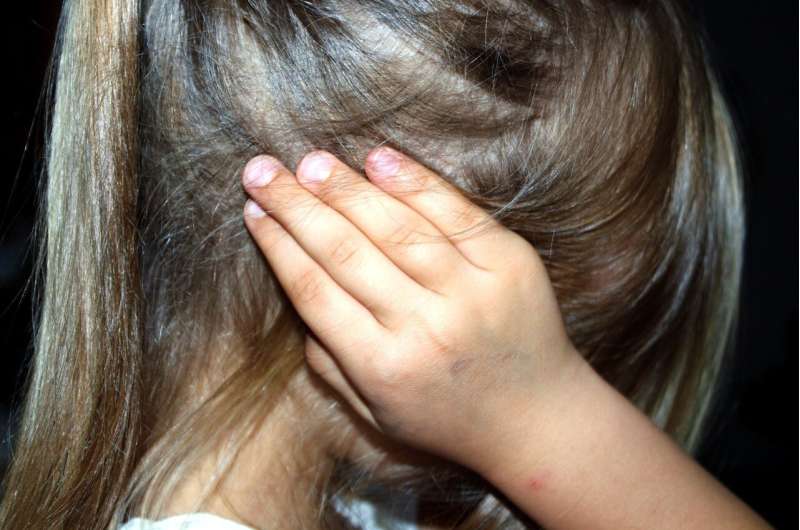This article has been reviewed according to Science X's editorial process and policies. Editors have highlighted the following attributes while ensuring the content's credibility:
fact-checked
reputable news agency
proofread
Understanding ear infection in children

"My ear hurts." There are many conditions that can trigger this complaint from a young child. Depending on the symptoms, causes of earache in children include a foreign object in the ear, the common cold, swimmer's ear and earwax blockage.
Another common cause of ear pain in children is an ear infection, or otitis media. It's an infection of the middle ear, the air-filled space behind the eardrum that contains the tiny vibrating bones of the ear. Children are more likely than adults to get ear infections.
An ear infection is caused by a bacterium or virus in the middle ear. This infection often results from another illness—cold, flu or allergy—that causes congestion and swelling of the nasal passages, throat and eustachian tubes, which are narrow tubes that run from the middle ear to high in the back of the throat.
Symptoms
The onset of signs and symptoms of ear infection is usually rapid.
Signs and symptoms common in children include:
- Ear pain, especially when lying down.
- Tugging or pulling at an ear.
- Trouble sleeping.
- Crying more than usual.
- Fussiness.
- Trouble hearing or responding to sounds.
- Loss of balance.
- Fever of 100 F or higher.
- Drainage of fluid from the ear.
- Headache.
- Loss of appetite.
Risk factors
Risk factors for ear infections include:
- Age. Children between 6 months and 2 years are more susceptible to ear infections because of the size and shape of their eustachian tubes and because their immune systems are still developing.
- Group child care. Children cared for in group settings are more likely to get colds and ear infections than children who stay home. The children in group settings are exposed to more infections, such as the common cold.
- Infant feeding. Babies who drink from a bottle, especially while lying down, tend to have more ear infections than do babies who are breastfed.
- Seasonal factors. Ear infections are most common during the fall and winter. Children with seasonal allergies may have a greater risk of ear infections when pollen counts are high.
- Poor air quality. Exposure to tobacco smoke or high levels of air pollution can increase the risk of ear infections.
- Alaska Native heritage.Ear infections are more common among Alaska Natives.
- Cleft palate.Differences in the bone structure and muscles in children who have cleft palates may make it more difficult for the eustachian tube to drain.
Treatment
Because ear infections often clear up on their own, treatment may begin with managing pain and monitoring the problem. Sometimes, antibiotics are used to clear the infection. What's best for your child depends on many factors, including your child's age and the severity of symptoms.
Your child's health care team may recommend:
- A wait-and-see approach. The American Academy of Pediatrics and the American Academy of Family Physicians recommend a wait-and-see approach as one option for:Children 6 to 23 months with mild middle ear pain in one ear for less than 48 hours and a temperature less than 102.2 F.Children 24 months and older with mild middle ear pain in one or both ears for less than 48 hours and a temperature less than 102.2 F.
- Managing pain. Your child's health care professional will advise you on treatments to lessen pain from an ear infection. These may include over-the-counter pain medications or anesthetic drops.
- Antibiotic therapy. Some evidence suggests that treatment with antibiotics might be helpful for certain children with ear infections. On the other hand, using antibiotics too often can cause bacteria to become resistant to the medicine.
Talk with your child's health care professional about the potential benefits and risks of using antibiotics. After an initial observation period, your child's health care professional may recommend antibiotic treatment for an ear infection in the following situations: Children 6 months and older with moderate to severe ear pain in one or both ears for at least 48 hours or a temperature of 102.2 F.Children 6 to 23 months with mild middle ear pain in one or both ears for less than 48 hours and a temperature less than 102.2 F.Children 24 months and older with mild middle ear pain in one or both ears for less than 48 hours and a temperature less than 102.2 F.
- Ear tubes. If your child has repeated, long-term ear infections (chronic otitis media) or continuous fluid buildup in the ear after an infection cleared up (otitis media with effusion), your child's health care professional may recommend ear tubes to drain fluid from the middle ear.
- Treatment for chronic suppurative otitis media. Chronic infection that results in a hole or tear in the eardrum—called chronic suppurative otitis media—is difficult to treat. It's often treated with antibiotics administered as drops. You may receive instructions on how to suction fluids out through the ear canal before administering drops.
- Monitoring. Children who have frequent infections or who have persistent fluid in the middle ear will need to be monitored closely. Talk to your child's health care professional about how often you should schedule follow-up appointments. They may recommend regular hearing and language tests.
2023 Mayo Clinic News Network. Distributed by Tribune Content Agency, LLC.





















